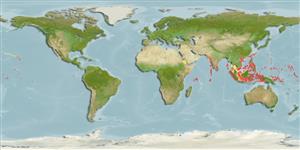Common names from other countries
>
Gobiiformes (Gobies) >
Gobiidae (Gobies) > Gobiinae
Etymology: Trimma: Greek, trimma, -atos = something crushed (Ref. 45335).
Environment: milieu / climate zone / depth range / distribution range
Ecologia
marinhas associadas(os) a recifes; intervalo de profundidade 20 - 50 m (Ref. 54980). Tropical; 28°N - 8°S
Indo-Pacific: Maldives to Hawaiian and Society Islands; Japan to Australia (Queensland and Northwest Shelf); throughout East Indian region.
Tamanho / Peso / Idade
Maturity: Lm ? range ? - ? cm
Max length : 3.5 cm SL macho/indeterminado; (Ref. 48637)
Espinhos dorsais (total): 7; Raios dorsais moles (total): 10-11; Espinhos anais 1; Raios anais moles: 9 - 10. Males have longer dorsal spines and yellow spotting on the fins (Ref. 1602); characterized further by semi-translucent upper part of body, pinkish orange below; head and median fins with yellow orange spots; elongate and filamentous second dorsal spine; fifth pelvic ray branched, 75-85% length of fourth ray; longitudinal scale series 23-24; predorsal scales absent; cheek and opercle without scales; depth of body 4.0-4.2 in SL (Ref. 90102).
Benthopelagic (Ref. 58302). Occur in caves of drop-offs at depths of about 25 to at least 50 m (Ref. 48637, 58302). Form loose schools near the roofs or sides of caves and disappears into holes or crevices when approached. Often seen with other species of Trimma and feeds on harpacticoid copepods (Ref. 48637).
Life cycle and mating behavior
Maturidade | Reprodução | Desova | Ovos | Fecundidade | Larvas
Myers, R.F., 1991. Micronesian reef fishes. Second Ed. Coral Graphics, Barrigada, Guam. 298 p. (Ref. 1602)
Categoria na Lista Vermelha da IUCN (Ref. 130435)
CITES (Ref. 128078)
Not Evaluated
Ameaça para o homem
Harmless
Utilização humana
Mais informação
Nomes comunsSinónimosMetabolismoPredadoresEcotoxicologiaReproduçãoMaturidadeDesovaFecundidadeOvosDesenvolvimento dos ovos
ReferênciasAquaculturaPerfil para aquaculturaEstirpesGenéticaElectrophoresesHereditariedadeDoençasProcessamentoMass conversion
Ferramentas
Relatórios especiais
Descarregue XML
Fontes da internet
Estimates based on models
Preferred temperature (Ref.
115969): 24.6 - 28.5, mean 27.9 (based on 85 cells).
Phylogenetic diversity index (Ref.
82804): PD
50 = 0.5000 [Uniqueness, from 0.5 = low to 2.0 = high].
Bayesian length-weight: a=0.01023 (0.00477 - 0.02194), b=3.02 (2.84 - 3.20), in cm Total Length, based on LWR estimates for this (Sub)family-body shape (Ref.
93245).
Nível Trófico (Ref.
69278): 3.0 ±0.00 se; based on food items.
Resiliência (Ref.
120179): Elevada, tempo mínimo de duplicação da população menor que 15 meses (Preliminary K or Fecundity.).
Fishing Vulnerability (Ref.
59153): Low vulnerability (10 of 100).
